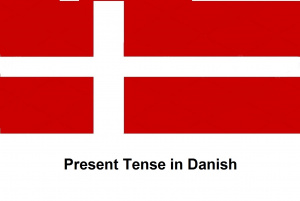Difference between revisions of "Language/Danish/Grammar/Present-Tense"
m (Quick edit) |
m (Quick edit) |
||
| Line 6: | Line 6: | ||
Feel free to edit this page by adding new words and expressions ! | Feel free to edit this page by adding new words and expressions ! | ||
In Danish, the conjugation of verbs is the same across all pronouns. | In Danish, the conjugation of verbs is the same across all pronouns. | ||
| Line 19: | Line 15: | ||
The Pronouns are : | The Pronouns are : | ||
Upon finishing this course material, you may want to delve into these connected themes: [[Language/Danish/Grammar/Danish-Alphabet|Danish Grammar → Introduction to Danish Alphabet and ...]], [[Language/Danish/Grammar/Conditional-Mood|Conditional Mood]], [[Language/Danish/Grammar/Comparatives-and-Superlatives|Comparatives and Superlatives]] & [[Language/Danish/Grammar/Regular-Verbs|Regular Verbs]]. | |||
{| class="wikitable" | {| class="wikitable" | ||
!'''<big><u>ENGLISH</u></big>''' | !'''<big><u>ENGLISH</u></big>''' | ||
| Line 57: | Line 53: | ||
|ELES | |ELES | ||
|} | |} | ||
Using the example of "at gå" (to go): | Using the example of "at gå" (to go): | ||
{| class="wikitable" | {| class="wikitable" | ||
| Line 102: | Line 94: | ||
|} | |} | ||
== | ==Other Lessons== | ||
* [[Language/Danish/Grammar/The-Genitive-Case-in-Danish|The Genitive Case in Danish]] | * [[Language/Danish/Grammar/The-Genitive-Case-in-Danish|The Genitive Case in Danish]] | ||
* [[Language/Danish/Grammar/The-Nominative-Case-in-Danish|The Nominative Case in Danish]] | * [[Language/Danish/Grammar/The-Nominative-Case-in-Danish|The Nominative Case in Danish]] | ||
| Line 112: | Line 104: | ||
* [[Language/Danish/Grammar/How-to-use-“can”-in-Danish|How to use “can” in Danish]] | * [[Language/Danish/Grammar/How-to-use-“can”-in-Danish|How to use “can” in Danish]] | ||
* [[Language/Danish/Grammar/How-to-use-“to-be”-with-names-and-places|How to use “to be” with names and places]] | * [[Language/Danish/Grammar/How-to-use-“to-be”-with-names-and-places|How to use “to be” with names and places]] | ||
<span links></span> | |||
Revision as of 20:09, 26 March 2023
Hello everybody,
In today's lesson you will learn how to use "THE PRESENT TENSE" in Danish.
Feel free to edit this page by adding new words and expressions !
In Danish, the conjugation of verbs is the same across all pronouns.
The infinitive verbs always end in -e, and are always preceded by the phrase "at". For example: "at gå", meaning "to go" or "to walk".
To form the present tense, you have to add -r to the verb, and replace the "at" with the correct pronoun depending on your subject.
The Pronouns are :
Upon finishing this course material, you may want to delve into these connected themes: Danish Grammar → Introduction to Danish Alphabet and ..., Conditional Mood, Comparatives and Superlatives & Regular Verbs.
| ENGLISH | DANISH | PORTUGUESE |
|---|---|---|
| I | JEG | EU |
| YOU | DU | VOCÊ |
| HE | HAN | ELE |
| SHE | HUN | ELA |
| WE | VI | NÓS |
| YOU (PLURAL) | I | VOCÊS |
| THEY | DE | ELES |
Using the example of "at gå" (to go):
| ENGLISH | DANISH | PORTUGUESE |
|---|---|---|
| I GO | JEG GÅR | EU VOU |
| YOU GO | DU GÅR | VOCÊ VAI |
| HE GOES | HAN GÅR | ELE VAI |
| SHE GOES | HUN GÅR | ELA VAI |
| WE GO | VI GÅR | NÓS VAMOS |
| YOU (PLURAL) GO | I GÅR | VOCÊS VÃO |
| THEY GO | DE GÅR | ELES VÃO |
Other Lessons
- The Genitive Case in Danish
- The Nominative Case in Danish
- Questions
- Adjectives
- Plurals
- The Accusative Case in Danish
- The Locative Case in Danish
- How to use “can” in Danish
- How to use “to be” with names and places
